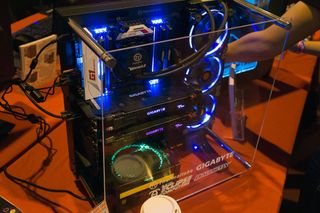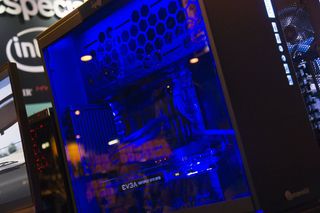To SLI or not SLI, that is the real GPU question

When looking at a GPU for enjoying games as they were intended, there's the decision as to whether or not to go with multiple affordable GPUs or a more expensive single unit. Having NVIDIA cards or AMD cards in SLI and Crossfire configurations can provide increased amounts of power for the buck compared against a single unit solution, but is it actually worth it?
How SLI and Crossfire work by connecting two compatible GPU cards with a bridge on a supported motherboard. SLI is slightly more restrictive — you need to install a pair of the same GPU, but they can be from different manufacturers. For example, you could hook up two GTX 980 Ti cards. As for Crossfire, you can mix up cards part of the same family. For more details on both systems, it's you should check out their corresponding support pages:
Configuring Crossfire and SLI setups can be carried out using either AMD or NVIDIA's control panel. Everything should be configured automatically once SLI or Crossfire is enabled. When firing up a game that supports multiple GPU cards, you should be able to enjoy increased performance compared to having just a single card installed. This is what the two systems are meant to push forward, but unfortunately there are some potential issues.
The Good
Install two GTX 1070s or GTX 1080s and you're packing quite the punch, so long as drivers support the game you wish to play (though increased performance can range from just 10% upwards). If scaling is solid you'll be able to bump settings to maximum and slide your resolution meter up to 4K with some comfortable frame rates.
DirectX 12 is set to change everything with SLI and Crossfire, allowing PC builders to combine more GPUs with increased support implemented by developers. We'd bet that we'll be seeing more support implemented for multiple video cards in the future, especially as more displays move into UHD territory.
The Bad

A major hurdle with multiple video cards is the support of games themselves. Unfortunately, even though you have multiple GPUs installed, configured correctly and meet all requirements, you may not be able to take full advantage of the extra capacity, depending on support for the title you wish to play. Even in 2016, this is still a problem.
GPUs draw power and produce some serious amounts of heat while under load. This can cause problems with heat management inside the chassis, but throw another card into the mix and you're doubling the output of warm air. Should you have a lack of cooling with a single card installed, you may need to look at improving flow with more fans or possibly invest in a water cooling solution.
Get the Windows Central Newsletter
All the latest news, reviews, and guides for Windows and Xbox diehards.
Much like heat, more power is required for multiple cards. We generally recommend a 500W power supply for a single GPU-powered system. Having two cards installed will require more electricity and thus you'd probably want to bump your power supply up to at least a 750W unit from a reputable brand. Lastly, you may encounter an issue with stuttering and frame pacing, which could actually provide a less than consistent experience. Not what you'd expect from multiple cards.
Conclusion
I'd always go for a single more powerful card than forking out for two less powerful solutions. I understand that not everyone is lucky enough to be in the position to purchase a GTX 1080, but having an immense amount of power in a single unit is better for game support, heat management, and lower power costs. That said, if you wish for your computer to look even more bad ass than it already is, throwing another of the best graphics card options into the chassis is a great upgrade.
At the end of the day, buying a more powerful GPU means you can always get another and upgrade to SLI and Crossfire at a later stage. But what are your thoughts on multiple GPUs? Sound off in the comments if you're rocking two cards!

Rich Edmonds was formerly a Senior Editor of PC hardware at Windows Central, covering everything related to PC components and NAS. He's been involved in technology for more than a decade and knows a thing or two about the magic inside a PC chassis. You can follow him on Twitter at @RichEdmonds.
